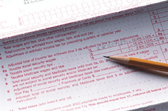
(See related pages)
Importance of Filing Business and personal records contain important information. However, without a systematic approach to organizing and storing records, their value is diminished. To avoid being buried in paperwork, one must determine which records to retain and which to discard. Once that decision has been made, it is important that documents be filed in a manner that allows the user to locate and retrieve them in an efficient, timely manner.
A file system can be extremely simple…
or quite complex.
The system must be designed to meet the needs of the individual or business it serves. Your study of the 12 basic filing rules can be the first step toward organizing and maintaining your personal records and the start on a professional path that can lead to a satisfying and rewarding career. How will you use what you learn in Gregg Quick Filing Practice? Names of People The application of the filing rules presented in Gregg Quick Filing Practice will enable you to file and locate needed information more quickly. As an individual you most likely maintain a file of names, addresses, and phone numbers of friends, relatives, and personal service providers. That file may be a small notebook, a computer file, or a rolodex. Such files are organized alphabetically. Rules 1-5 deal with proper filing of personal names. When you visit your favorite media store, you will find that CDs are arranged in alphabetic order by artist’s name. Thus it is imperative that you know how hyphenated names and names with prefixes are indexed. Business and Organization Names Your address file most likely contains business and organization names as well as those of individuals. For example, your list will likely have the names of your doctor and dentist, your bank, the gym where you work out, etc. While names of businesses and organizations are also arranged alphabetically, there are specific rules (Rules 6-10) related to indexing and filing such names. Government Names If you need to renew your driver’s license, you will find the location of the nearest Bureau of Motor Vehicles by searching the blue pages of your local telephone directory. After you learn Rule 11, you will be able to locate quickly the listings for local, state, and federal government entities. Addresses When the names of individuals, businesses, or organizations are the same, the address is used to determine the filing sequence. Rule 12 will clarify the order in which such names are filed. For example, if your dentist practices in two locations, the addresses are used to determine which phone number appears first in the telephone directory. Subject Filing If you need to call a plumber, electrician, or a carpet cleaning service, you will likely use the yellow pages because those listings are arranged by subject. Within each subject, businesses are then arranged alphabetically. You will find that some subjects are filed in subsets. For example, when you look in the category for Physicians and Surgeons, you will find the listing grouped by specialties such as Cardiology, Dermatology, Family Practice, etc. Subdividing a major category in this manner decreases the time it takes one to locate the desired entry.
Correspondence Filing Correspondence is frequently filed alphabetically by the individual or business name. The filing order is determined by Rules 1-12. In some instances, however, it is more practical to file correspondence and other records according to the subject of the correspondence. For example, to maintain necessary documentation for filing personal income taxes, a subject file would be appropriate with individual folders for major deductible items. Perhaps an organized subject filing system will eliminate some of the stress related to this necessary task. Often personal tax preparation files look like this,
rather than a proper filing system where needed information can be retrieved quickly.
Medical offices often use a combination of alphabetic and numeric filing systems. Medical personnel must check both the patient name and patient number to assure that they are gathering information from or giving information to the correct person..
Because of the large number of files involved, medical folders are color coded to speed up the sorting process. For example, patients whose last names begin with A or B may have folders with a red tab or stripe; those whose names begin with C and D, may have blue tabs or stripes, etc. Folders can be sorted by color quickly and then arranged alphabetically within each color sort.
Numeric Filing Examples of numeric filing include insurance policies, bank statement listing of cancelled checks, Social Security records, or even a traffic citation. Documents can be filed numerically more quickly than they can be indexed and filed alphabetically.
Career Planning Records and Information Management is a growing career field. To verify this statement, visit monster.com. A search of records management and related job titles will reveal the increasing need for individuals who are trained to manage the enormous volume of paper and electronic files that are essential in today’s business environment. For information to be useful it must be available when and where it is needed. Your study of filing rules is the foundation for records and information management careers. You can find the answers to frequently-asked questions about records management from the national archives site http://www.archives.gov/records-mgmt/faqs/general.html#whatrm. As noted in the Gregg Quick Filing Student Text Guide, the filing rules you will learn are based on those established by ARMA International http://www.arma.org/about/overview/index.cfm.
|










